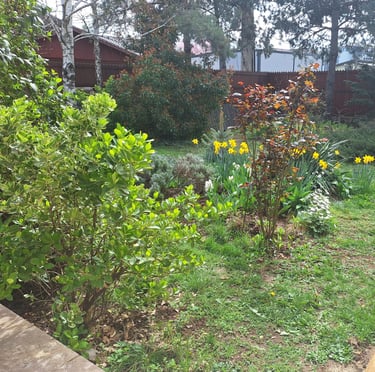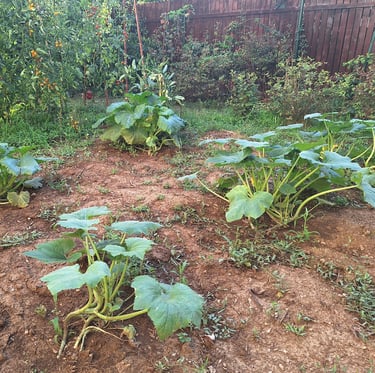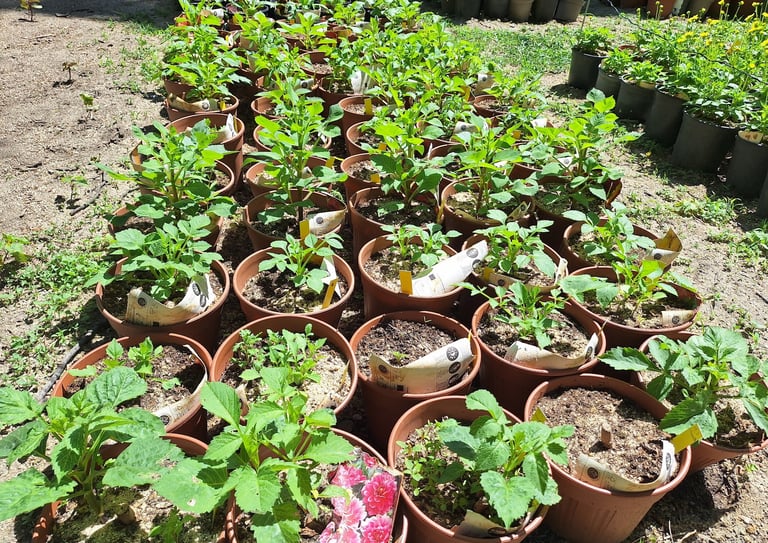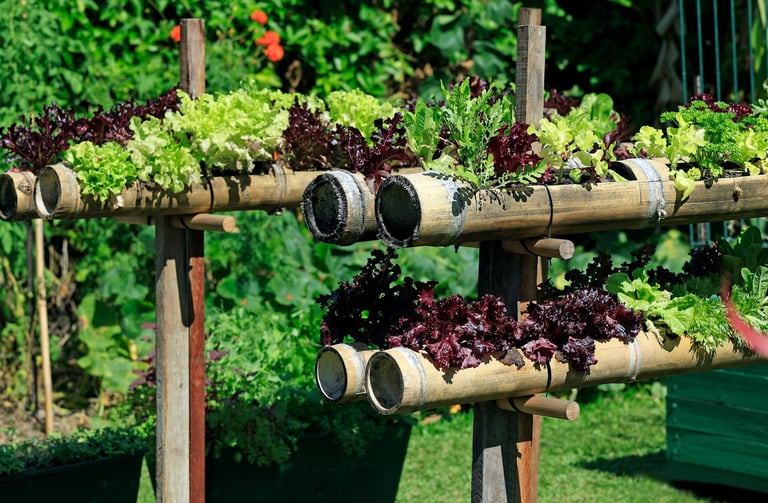Start and Grow an Informal Garden + Tips & Tricks
Unlike formal gardens, which are often symmetrical and meticulously planned, informal gardens embrace a more relaxed, free-flowing design.
In this article, we'll guide you through the process of starting and growing an informal garden, along with some tips and tricks that we've found helpful in our own gardening experience.








Understanding the Informal Garden
An informal garden is characterized by its casual layout and natural look. Paths meander, plants spill over borders, and there’s a mix of colors and textures that create a harmonious, yet unstructured feel.
The goal is to create a garden that feels like a natural extension of the landscape, where plants grow as they would in the wild.
This approach is not only visually pleasing but also tends to be lower maintenance compared to more formal styles.
Steps to Start an Informal Garden
1. Plan Your Space
Although informal gardens are more relaxed, some planning is still essential like where you want the borers, beds, or elevations to be. But first, begin by assessing the area where you want to create your garden.
Observe the sunlight patterns, soil conditions, and existing features like trees, rocks, or slopes. In our experience, starting with a rough sketch of your garden layout helps to visualize the space.
Mark where you want to place pathways, seating areas, and larger plants or shrubs.
2. Choose the Right Plants
Select plants that are suited to your climate and soil type. In informal gardens, native plants work particularly well because they’re adapted to the local environment and often require less maintenance.
We’ve seen that mixing perennials, annuals, shrubs, and grasses creates a lush and diverse garden. Consider plants with varying heights, colors, and textures to add interest throughout the year.
Don’t be afraid to let some plants self-seed and spread naturally, this adds to the informal look.
3. Create Natural-Looking Pathways
Paths in an informal garden should feel like they’ve always been there. Instead of straight lines, opt for gently curving pathways made from materials like gravel, mulch, or stepping stones.
We’ve found that using locally sourced materials helps the garden blend more seamlessly with its surroundings. Allow plants to soften the edges of the paths, spilling over slightly to create a relaxed vibe.
4. Embrace Organic Shapes
Forget about straight lines and perfectly trimmed hedges. Informal gardens are all about organic shapes and free-flowing forms.
When planting, arrange plants in groups of odd numbers and in staggered patterns rather than rows. This mimics how plants naturally grow in the wild.
As the garden matures, it will take on a more natural and established look, which is exactly what you want.
5. Add Personal Touches
An informal garden is the perfect canvas for your creativity. We’ve seen that adding personal touches, like rustic benches, birdbaths, or even a small pond, can make your garden feel like a true reflection of your personality.
Consider incorporating garden art or repurposed materials to add character. Remember, the key is to keep things casual and not overly designed.


5 Expert Tips for Informal Gardening
Mix Plant Varieties
Combine a diverse range of plants, including perennials, shrubs, ornamental grasses, and wildflowers.
This mixture not only adds texture and vibrant color to your garden but also encourages a more natural growth pattern.
Choose plants that complement each other in terms of height, foliage, and blooming seasons, ensuring year-round interest. Additionally, selecting plants suited to your local climate will reduce maintenance efforts.
Prioritize Low-Maintenance Plants
Focus on hardy, low-maintenance plants that require minimal care. Opt for native species and plants that thrive in your region’s climate, which will reduce the need for frequent watering, pruning, and pest control.
This choice helps maintain the garden’s informal and relaxed appearance while also being environmentally friendly.
Over time, these plants will establish themselves with minimal intervention, contributing to a garden that practically takes care of itself.
Let Plants Spread Naturally
Give your plants the freedom to self-seed and spread naturally within the garden. This hands-off approach fosters a sense of spontaneity and unpredictability, key characteristics of informal gardens.
As plants establish themselves and expand their territory, the garden will evolve organically, adding layers of interest and charm over time. This natural spread creates a dynamic, ever-changing landscape that feels alive and untamed.
Incorporate Rustic Elements
Use natural, rustic materials like wooden fences, stone paths, and weathered garden furniture to enhance the informal feel of the garden. These elements blend seamlessly with the garden’s aesthetic, adding warmth and character.
Consider using reclaimed or aged materials for a more authentic look, and let these features integrate with the landscape, softening over time as they become part of the garden’s natural tapestry.
Encourage Wildlife
Attract local wildlife by planting nectar-rich flowers, installing bird feeders, or adding a small pond.
Encouraging birds, butterflies, bees, and other beneficial creatures not only enhances the garden’s natural beauty but also supports local ecosystems.
These elements bring life and movement to your garden, making it a vibrant and interactive space where nature can thrive alongside your plants.











Informal Gardening Soil Preparation and Improvement
Soil is the foundation of any successful garden, and in informal gardening, it's particularly important to work with what you have. Before planting, assess the quality of your soil. Is it sandy, clay-heavy, or loamy?
Each type has its own characteristics, and understanding these will help you choose the right plants.
Improving the soil structure can greatly benefit plant growth. We’ve found that adding organic matter, such as compost or well-rotted manure, helps to improve soil fertility and drainage.
For particularly poor soils, consider double digging, this method involves loosening the soil to a greater depth, allowing roots to penetrate more easily.
Seasonal Planting in Informal Gardens
Understanding the seasonal changes in your garden is key to maintaining a vibrant informal garden throughout the year. Different plants thrive in different seasons, so planning your garden to have something blooming in every season will keep it looking lively.
In spring, bulbs like daffodils and tulips can provide early color, while in summer, perennials such as coneflowers and black-eyed Susans will take center stage. Autumn is the perfect time for asters and chrysanthemums, which add bursts of color as the temperatures cool.
Winter doesn’t have to be dull, evergreens and plants like winterberry can offer structure and color even in the coldest months.
Companion Planting Strategies
Companion planting is a time-tested technique that can enhance the health and productivity of your garden. By placing certain plants near each other, you can naturally deter pests, improve pollination, and even boost flavor.
For example, planting marigolds near vegetables can help repel harmful insects, while herbs like basil and thyme can improve the growth and flavor of tomatoes.
In informal gardens, companion planting fits naturally with the idea of mixing different types of plants together.
We’ve experienced that this method not only reduces the need for chemical pesticides but also adds to the diversity and beauty of the garden.
Watering Techniques and Irrigation Systems
Watering is a crucial aspect of garden care, and in an informal garden, the goal is to keep it as natural and sustainable as possible. While traditional sprinklers can waste water, drip irrigation systems are a more efficient option. These systems deliver water directly to the roots, minimizing evaporation and runoff.
In areas with low rainfall, xeriscaping using drought-tolerant plants and minimal water—can be an effective strategy.
We’ve seen that incorporating rain barrels to collect and reuse rainwater is another sustainable practice that works well in informal gardens. Additionally, grouping plants with similar water needs together will help ensure that each plant receives the appropriate amount of moisture.
Dealing with Weeds in Informal Gardens Naturally
Weeds are a common challenge in any garden, but in an informal setting, they can often be managed without resorting to harsh chemicals. Regular mulching is one of the best ways to suppress weeds, as it blocks sunlight from reaching weed seeds, preventing them from germinating.
Hand weeding is another effective method, especially when done regularly. We’ve found that pulling weeds after a rain, when the soil is moist, makes the task easier and more effective.






FAQs: Understanding Informal Gardens
What is an informal garden?
An informal garden is a natural, relaxed garden design that mimics nature. It features flowing lines, asymmetrical layouts, and a mix of plant types that grow freely without strict structure.
This style encourages a harmonious blend of colors and textures, creating a serene and organic outdoor space.
Is an English garden formal or informal?
An English garden can be both formal and informal. Traditional English gardens often feature structured layouts with formal elements, but many English cottage gardens are known for their informal, naturalistic planting styles.
Is the Japanese garden informal?
Japanese gardens are generally formal, focusing on careful design, symmetry, and symbolism. However, some Japanese garden elements, like natural stone paths, Japanese ornamental plants, Japanese flowers, and water features, can inspire informal garden settings.
What are some basic informal garden ideas?
To create an informal garden, focus on curving pathways, diverse plantings, and natural elements like rocks or water features.
Mix wildflowers, shrubs, and perennials for a layered look. Allow plants to grow in a more relaxed, natural manner, avoiding rigid structures.

Sources
Nature and Sustainability uses only high-quality sources, including peer-reviewed studies to support the facts we describe in our articles. Please read our editorial policy to learn more about how we keep our content accurate, reliable, and trustworthy.
General Info on Informal Garden: Design a Garden (bhg.com), Natural landscaping - Wikipedia, Vertical Gardening | The Old Farmer's Almanac, How to start a container garden (nationalgeographic.com), English Garden Ideas & Elements | Garden Design
Plants: Types of Wildflowers (thespruce.com), Native species - Wikipedia, Nectar Plants for Pollinators (bhg.com)
Share this article:




Article By:
Calin is in the garden industry for 5 years now and knows a lot about gardening and plants. He is the owner of this website and responsible for most of the content.

